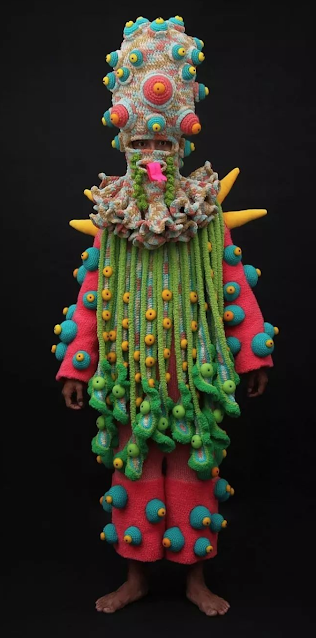Featured
- Get link
- X
- Other Apps
Shape-changer? Pukwudgie + The Abbots Bromley Horn Dance
 |
| my carpet ghosts |
SOURCE
(UK) What of the supernatural world that the anonymous author portrays in the North York Moors, some (600) six hundred years ago? There were doubtless many different forms of the supernatural there, as there were in the 1800s in the same area, when folklore was collected in a more systematic fashion. But there are two striking forms that emerge from the Byland tales: the shape-changer (shapeshifter) and the revenant.
The shape-changer is familiar from later folklore in the same part of Yorkshire, and, indeed, through most of England. These are beings that change from one form to another to frighten or to catch the attention of night-time walkers: in one moment they are, thinking of tale 2: a raven, then a peat stack (though the Latin is uncertain), then a dog, then a she goat, then a tall cadaverous human. In tale 8 (in another difficult Latin passage) we seem to have a later shape-changing favourite from the north: the rolling wool bogey (a shape-changer in the form of a bale of textiles spinning along the ground). The Byland author, like some later folklore writers, associates these shapechangers with spirits of the dead.
**We will never know the circumstances in which the anonymous author put down his tales. But anyone interested in English folklore has reasons to be grateful to him for doing so.**
(WAIT... WHAT?👀)
Pukwudgie
Many American Indian mythologies have stories of little people. The Wampanoag of Massachusetts’ legend is of the Pukwudgie. Jealous of the affection the Wampanoag showed the giant Maushop (well, the giant did create Cape Cod for them), the Pukwudgie began to torment the Wampanoag Indians, playing tricks on them, stealing their children, and burning their villages. Pukudgies are described as humanlike, two to three feet tall with large noses, and ears. Their skin is grey.
The Pukwudgie can become invisible, use magic, and create fire at the snap of their fingers, but their most dangerous antics involve shooting poison arrows (with which legend says they used to kill Maushop and his five sons), and turning into a half-porcupine/half-troll. These diminutive human-like monsters have been known to lure humans to their deaths either by poison arrow, or pushing the human off a cliff. Afterward, the Pukwudgie can control the souls of their victims.
In modern times, people have reported encountering Pukwudgies in Freetown-Fall River State Forest, which includes a reservation in the Wampanoag Nation.
BRITISH FOLK MUSEUM?
The Museum of British folklore is an ambitious project that seeks to promote, celebrate and record the rich folk heritage of Britain to this wide audience, and Costin aims to create a permanent museum to house their growing collection of British folkloric treasures. READ: https://museumcrush.org/the-museum-of-british-folklore-celebrating-the-magic-and-ritual-of-our-lives/
- Get link
- X
- Other Apps

easy, right? click on older posts
Contact Me


indeed!
a good thing...

Popular Posts
OTIS: Hazel's blog on Thread, Fashion and Costume: Mulyana
- Get link
- X
- Other Apps
Santa is a Monk or a Psychedelic Mushroom?
- Get link
- X
- Other Apps







Comments
Post a Comment
send me your idea!